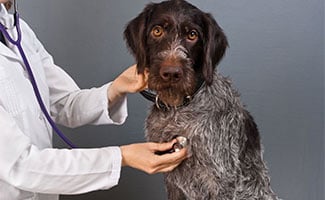
 Vestibular disease (or vestibular syndrome) refers to a group of diseases that affect a dog’s balance system (known as the vestibular system or vestibular apparatus). Common signs of vestibular disease in dogs include loss of balance, falling over, an abnormal flickering of the eyes, and general wobbliness. These signs can occur very suddenly and nearly always warrant veterinary attention. What causes vestibular disease? How is it diagnosed and treated? And what can you do at home to help your canine friend recover?
Vestibular disease (or vestibular syndrome) refers to a group of diseases that affect a dog’s balance system (known as the vestibular system or vestibular apparatus). Common signs of vestibular disease in dogs include loss of balance, falling over, an abnormal flickering of the eyes, and general wobbliness. These signs can occur very suddenly and nearly always warrant veterinary attention. What causes vestibular disease? How is it diagnosed and treated? And what can you do at home to help your canine friend recover?
Article Overview
Contents
What Causes Vestibular Disease In Dogs?
 The body’s vestibular system controls your dog’s ability to balance. It consists of sensors located deep inside the ear (referred to as the peripheral vestibular apparatus) and a control center located at the back of the brain (called the central vestibular apparatus).
The body’s vestibular system controls your dog’s ability to balance. It consists of sensors located deep inside the ear (referred to as the peripheral vestibular apparatus) and a control center located at the back of the brain (called the central vestibular apparatus).
Vestibular syndrome in dogs can be caused by a disease affecting any part of this system — the sensors within the ear, the nerve connecting the ear and brain, or the control center in the brain. Possible underlying causes of vestibular disease are:
Diseases Affecting The Ear
- Ear infections
- Ear tumors
- Ear polyps
- Trauma or injury
- Toxins to the middle ear, e.g., some medications in ear drops if the eardrum is ruptured
Diseases Affecting The Vestibular Nerve
- Nerve tumors
- Nerve inflammation (neuritis)
- Hormonal imbalance, e.g., hypothyroidism (an underactive thyroid)
Diseases Affecting The Brain
- Brain tumor
- Inflammation or infection of the brain (encephalitis)
- Head trauma
- Stroke
- Congenital malformations of the brain, e.g., a cyst
- Vitamin deficiencies, e.g., thiamine deficiency
Old Dog Vestibular Disease
Many dogs, particularly older dogs, will not have an underlying cause for vestibular syndrome. This form of vestibular disease is often self-limiting and resolves with time. It’s sometimes referred to as “canine idiopathic vestibular disease” or “old dog vestibular disease” and is more common in dogs over eight years of age.
What Are The Symptoms Of Vestibular Disease?
 Your dog’s vestibular system is responsible for controlling balance, which is why dogs with vestibular disease will have difficulty walking, may fall over, and feel dizzy. The balance center in the brain is very close to the area of the brain that controls vomiting, so animals with vestibular disease may also feel nauseous or sick. If the vestibular disease is caused by a problem within the brain, then other areas of the brain can be affected causing seizures, weakness, or loss of vision.
Your dog’s vestibular system is responsible for controlling balance, which is why dogs with vestibular disease will have difficulty walking, may fall over, and feel dizzy. The balance center in the brain is very close to the area of the brain that controls vomiting, so animals with vestibular disease may also feel nauseous or sick. If the vestibular disease is caused by a problem within the brain, then other areas of the brain can be affected causing seizures, weakness, or loss of vision.
Symptoms can last from a few minutes to several weeks and vary hugely in their severity. Common symptoms of vestibular disease in dogs include:
- Head tilt
- Circling in one direction
- Loss of balance/falling over
- Vomiting or nausea
- Excessive drooling
- Flickering eyes from side to side or up and down (nystagmus)
- General wobbliness and lack of coordination
Vestibular disease commonly only affects one side of the body. For example, if your dog’s head tilt is to the right side (with the right ear held lower than the left), then she will generally fall to the right side and may also turn in circles to the right side. A dog head tilt on its own can be a sign of ear disease or neurological problems and often needs further investigation by a veterinary surgeon.
What Will My Vet Do To Diagnose Vestibular Disease?
 It’s essential to seek immediate veterinary advice if you suspect your dog has vestibular disease as the symptoms can be similar to other neurological conditions that require different treatment. Your veterinarian will perform a neurological examination to determine if the problem is more likely to be central (in the brain) or peripheral (in the ear).
It’s essential to seek immediate veterinary advice if you suspect your dog has vestibular disease as the symptoms can be similar to other neurological conditions that require different treatment. Your veterinarian will perform a neurological examination to determine if the problem is more likely to be central (in the brain) or peripheral (in the ear).
They might examine your dog’s ears with a light and take a swab to check for an ear infection. If your vet suspects disease located beyond the eardrum or if your dog has recurring episodes of vestibular disease, blood tests, x-rays, or scans (such as CT or MRI) may be needed.
How Is Vestibular Disease Treated?
 Most idiopathic or old-dog vestibular disease cases will slowly improve over two to three weeks. Your veterinarian may prescribe medication to control nausea. In severe cases, your dog may need to be hospitalized for IV fluids (drip) if she’s unable to drink on her own and requires specialized nursing care.
Most idiopathic or old-dog vestibular disease cases will slowly improve over two to three weeks. Your veterinarian may prescribe medication to control nausea. In severe cases, your dog may need to be hospitalized for IV fluids (drip) if she’s unable to drink on her own and requires specialized nursing care.
Otherwise, treatment aims to identify and treat the underlying cause of the vestibular syndrome. If irreversible damage has occurred to the balance sensors, then your dog may be left with permanent head tilt or balance problems despite adequate treatment.
How To Feed A Dog With Vestibular Disease
 A well-balanced, complete diet is recommended for dogs with vestibular disease to ensure your dog has all the nutrients she needs to heal and recover. Dogs with vestibular disease may feel sick and need tempting with small amounts of fresh food, such as cooked chicken. Your veterinarian may be able to prescribe anti-sickness medication if your dog’s appetite is being affected by nausea.
A well-balanced, complete diet is recommended for dogs with vestibular disease to ensure your dog has all the nutrients she needs to heal and recover. Dogs with vestibular disease may feel sick and need tempting with small amounts of fresh food, such as cooked chicken. Your veterinarian may be able to prescribe anti-sickness medication if your dog’s appetite is being affected by nausea.
If your dog needs support to stand and eat, you can assist her by hand-feeding small amounts until she regains her balance. If she eats while lying down, make sure you support your pup with towels or blankets to prop her upright so that she doesn’t choke or regurgitate food.
Are There Any Natural Or Home Remedies For Dogs With Vestibular Disease?
 The most important thing to do at home to help your dog recover from vestibular disease is to provide her with a comfy place to rest. Ensure your dog has easy access to food and water.
The most important thing to do at home to help your dog recover from vestibular disease is to provide her with a comfy place to rest. Ensure your dog has easy access to food and water.
Since vestibular disease causes problems with your dog’s balance, it’s helpful to keep the space around your dog clear, avoid steps or stairs as your dog may fall, and provide blankets or a mattress on the floor if she finds it challenging to climb into her regular bed. Your dog may need help standing to go potty. You can use a towel placed gently underneath your dog’s belly and chest as a sling to help them gain balance when standing.
Over-the-counter antihistamine tablets such as Benadryl (diphenhydramine) may help control the symptoms of nausea and dizziness. Certain essential oils such as peppermint, ginger, and chamomile may also help to reduce nausea in dogs. However, you should seek veterinary advice before giving your dog any medication and confirm the diagnosis first.
Other Frequently Asked Questions
 Here are some questions our readers ask most often about vestibular disease.
Here are some questions our readers ask most often about vestibular disease.
What If My Dog Isn’t Recovering From Vestibular Disease?
If your dog isn’t recovering from vestibular disease as quickly as you would expect, you should seek veterinary advice to assess an underlying cause that requires different treatment.
What Are The Best Exercises For Dogs With Vestibular Disease?
Exercises that challenge your dog’s balance can aid in recovery. However, it’s not advised to do these in the early stages of vestibular disease if your dog is falling over, is very nauseous, or still has nystagmus (flickering eyes). In the early stages, your dog needs rest, support to help him sit up, and assistance with eating, drinking, and potty time.
Once you see some improvement in your dog’s symptoms, you can use a sling or your hands to support your dog in a standing position. Maintain this position for one minute and slowly build up to five minutes over several days. As your dog’s balance improves, remove your hands or the sling and see if your dog can stay balanced, getting ready to catch her if she falls.
Once your dog can stand and balance, try challenging this further by rocking her from side to side in a swaying motion to transfer his weight from the right to the left side. Do this for one minute and repeat two to three times per day.
Old-Dog Vestibular Disease vs A Stroke: How Can I Tell The Difference?
A stroke occurs when a blood vessel becomes blocked or narrows, so blood and oxygen are no longer delivered to the brain, causing brain cells to die. Dogs will show different neurological signs depending on the part of the brain affected and the severity of the damage.
A stroke can occur in the part of the brain that controls balance and results in vestibular syndrome. Only a veterinary professional can diagnose vestibular disease. With the help of a neurological examination and diagnostic tests, vets will be able to tell the difference between vestibular disease and a stroke in dogs.
Is There A Cure For Vestibular Disease In Dogs?
The treatment for vestibular disease depends on the underlying cause. Idiopathic or old dog vestibular disease will generally resolve on its own given time, although some dogs may be prone to it recurring. Vestibular disease that occurs secondary to infections or inflammation will require treatment. The prognosis is very variable, but many dogs make a full recovery.
How Long Does Recovery Take?
The recovery period depends on the underlying cause. Diseases such as ear infections or inflammation can take a long time to heal. Some conditions are relatively easy to control, while others are more serious. The prognosis is generally worse if your dog has a tumor. Most dogs with idiopathic or old-dog vestibular disease will slowly recover over two to three weeks. However, some may damage the balance system permanently, resulting in an abnormal gait or a head tilt.
Dealing with Doggy Dizziness
It can be very distressing to watch your dog staggering, falling, or struggling to balance. You can do many things to help support your canine friend and, hopefully, help them return to full health. Your first step should be to visit your veterinarian to confirm the diagnosis and help find the best treatment options for your pup. Learn about other conditions that can cause your dog to lose balance and fall over and an inherited disorder called exercise-induced collapse.
Disclaimer: This website contains reviews, opinions and information regarding products and services manufactured or provided by third parties. We are not responsible in any way for such products and services, and nothing contained here should be construed as a guarantee of the functionality, utility, safety or reliability of any product or services reviewed or discussed. Please follow the directions provided by the manufacturer or service provider when using any product or service reviewed or discussed on this website.